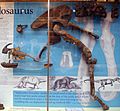Duriavenator facts for kids
Quick facts for kids Duriavenator |
|
|---|---|
 |
|
| Holotype | |
| Scientific classification | |
| Genus: |
Duriavenator
|
| Species: |
hesperis
|
| Synonyms | |
|
Megalosaurus hesperis Waldman, 1974 |
|
Duriavenator is a type of theropod dinosaur that lived about 170 million years ago. It was a meat-eating dinosaur that walked on two legs. Scientists first described it in 2008.
This dinosaur's fossils were found in Dorset, a county in England. The main species that defines this group, or genus, is called Duriavenator hesperis. It was once known as Megalosaurus hesperis.
Duriavenator lived during the Middle Jurassic period. It is one of the oldest known tetanurans. Tetanurans are a large group of theropod dinosaurs that include many well-known species, and even birds today.
The name Duriavenator has a special meaning. It combines Duria, which is the old Latin name for Dorset, with venator, a Latin word meaning "hunter". So, its name means "Dorset hunter". This dinosaur also had an unofficial nickname, "Walkersaurus".
Contents
Discovering Duriavenator
Duriavenator was first identified from fossils found in Dorset, England. These fossils give us clues about what this ancient hunter was like. Scientists study these remains to learn about dinosaurs that lived long ago.
What Was Duriavenator Like?
As a theropod, Duriavenator was a predator. It likely hunted other animals for food. While we don't have a complete skeleton, scientists can learn a lot from the bones found. They compare them to other similar dinosaurs.
Its Place in the Dinosaur Family Tree
Duriavenator belongs to a group called tetanurans. This group includes many famous meat-eating dinosaurs. For example, Torvosaurus is a more complete megalosaurid that helps us understand Duriavenator. Studying these connections helps scientists understand how dinosaurs evolved.
Images for kids
-
This image shows the lower jaw of Megalosaurus bucklandii and other related specimens. These are found at the Oxford University Museum of Natural History.
-
This is a reconstructed skeleton of Torvosaurus. It is a type of megalosaurid that we know more about. You can see it at the Museum of Ancient Life.
See also
 In Spanish: Duriavenator hesperis para niños
In Spanish: Duriavenator hesperis para niños





